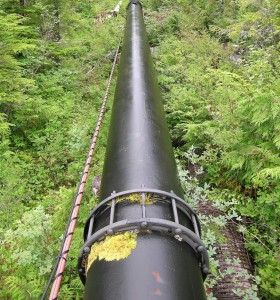 The Yellowstone oil spill has fouled land and water in Montana, but a leak from the Keystone XL pipeline would be far more disastrous.
The Yellowstone oil spill has fouled land and water in Montana, but a leak from the Keystone XL pipeline would be far more disastrous.
Less than two weeks after the Yellowstone River oil spill, the situation is as nasty as you might expect. Exxon maintains that oil has been found 25 miles downstream, but the Department of Transportation says some of the crude has traveled 240 miles. If you live ten miles from the spill site, you’re in bad shape either way.
Although the long-term effects are uncertain, the spill’s immediate impact is already clear. Ranchers awoke the morning after the spill to find their fields sticky with oil. So far, 40 landowners have reported fouled property. For example, one woman, who raises livestock, wheat, alfalfa, and hay, told Reuters, “All of our grasslands… have thick, black crude stuck to all the grass, trees, low lands.”
Water contamination is another concern. Communities that rely on the Yellowstone for drinking water have shut off their intake valves, and farmers have been advised against using the river water for irrigation. In addition, a number of people have reported breathing problems and dizziness, attributed to the fumes.
We don’t know how long these emergency conditions will last, but it will likely take years for the region to fully recover. That a relatively small spill — 42,000 gallons, according to Exxon; or 63,000 gallons, according to SkyTruth — could cause this much damage, should highlight the risks of the proposed 2,000-mile Keystone XL pipeline.
Carrying crude oil from Alberta tar sands to Texas refineries, TransCanada’s Keystone XL would cross almost 2,000 rivers, including the Yellowstone. And a leak from the XL that lasted as long as the Montana spill could release nearly 1,000,000 gallons, since the capacity of the pipe is 20 times larger.
The State Department is ready to approve the new pipeline, based largely on reports presented by TransCanada. But a University of Nebraska study released last week found that the company’s worst-case scenarios were “unrealistically optimistic.” The analysis states that TransCanada made “flawed and inappropriate assumptions about the frequency and severity of expected spills from its pipelines.”
According to the study:
- The pipeline could have 91 “significant” spills of over 2,100 gallons during its lifetime. (TransCanada’s estimate was 11 significant spills.)
- A rupture could take ten times as long to shut down and spill six times as much raw oil as TransCanada predicted.
- The Keystone XL could spill 6.9 million gallons of oil into the Yellowstone River, and as much as 7.9 million gallons in Nebraska’s Sandhills.
What’s special about the Nebraska Sandhills? Besides supporting the most intact ecosystem on the Great Plains, the Sandhills are home to the world’s largest underground reservoir, the Ogallala Aquifer. The Ogallala supplies drinking water to millions of people in eight states and provides over a quarter of U.S. agricultural water.
The Keystone XL would carry raw oil from the tar sands straight through this region. And it might leak almost 8 million gallons of oil in the process. The Gulf oil spill should have taught us that worst-case scenarios can and do happen.
Predictably, TransCanada has circulated a rebuttal of the UNL study, patiently explaining why the points quoted above are wrong. But the problem isn’t just about which figures are correct. What worries me is the disparity between the numbers. Why is the government ready to approve a potentially disastrous project without a clear idea of what could go wrong?
We, the public, do know one thing for sure: When an oil company starts reassuring us, it’s time to be on our guard. BP said its deepwater wells were safe. Exxon said its Montana pipeline was safe, even after inspectors found a problem. Now, TransCanada is promising us that the Keystone XL will be safe.
If I had sound effects, I’d be hitting hitting the siren button now.
But I’ll end on a serious tone. We can’t expect the fossil fuel industry to change course and choose people over profits, and we can’t expect the government to learn from its past mistakes. But that doesn’t mean we have to stand by and watch. Awareness is crucial; the next step is action.
What you can do now: Tell President Obama we need stronger regulations, not new oil pipelines.
What you can do offline: Spread the word about the dangers of new oil pipelines and support direct-action efforts to block the Keystone XL.